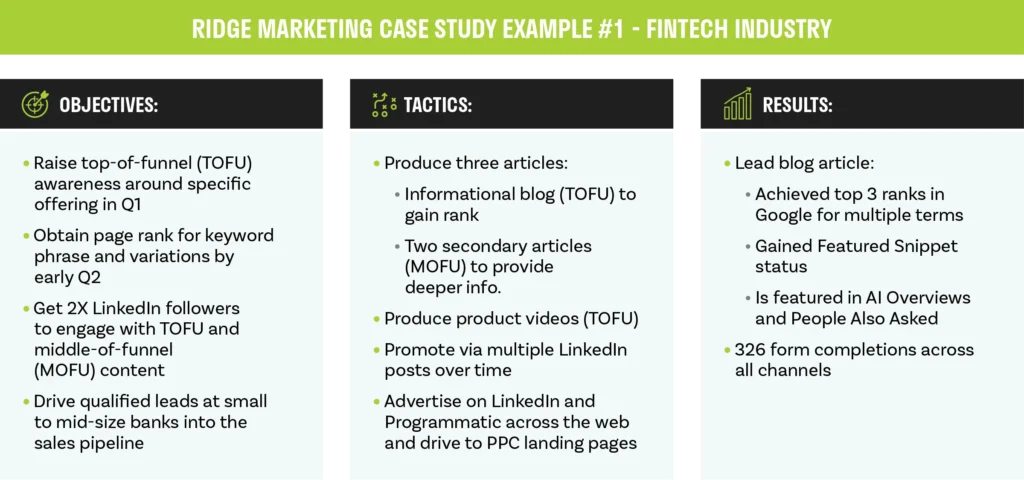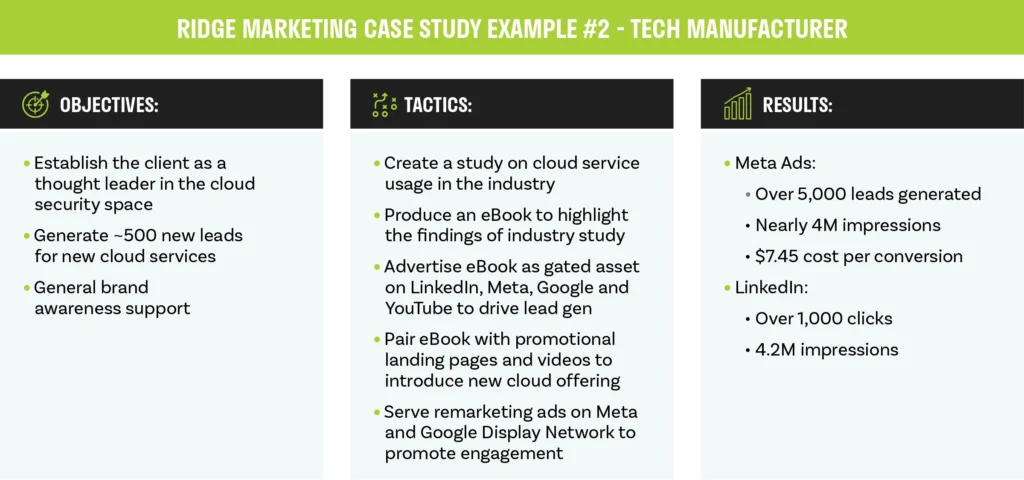Let’s be honest… setting content goals is something we all know we should do, but somehow always falls to the bottom of the to-do list.
Believe me, I get it. You’re busy creating blogs, guides and campaigns to keep up. But without clear goals, it’s hard to know if all that work is actually moving the needle. Good content marketing isn’t just about posting. It’s about performance.
Setting strong content marketing goals isn’t complicated. Creating engaging content, identifying the right tracking metrics and tying your efforts to business outcomes will help create clarity across your team and put you on the road to ROI.
Let’s dig into how to set content goals that drive results.

STRATEGICALLY BUILD YOUR CONTENT CALENDAR
It’s easy to fall into the trap of creating content just for the sake of it. You may be cranking out blogs, researching eBooks and posting on social, but are you doing so just to check the “we’re doing content” box? Without clear content objectives tied to business goals, even the best content pieces can fall flat.
A good content marketing strategy should obviously align with sales and marketing priorities. But it’s equally important to consider what else is happening across your organization and the marketplace. Is the product team launching a new update this quarter? Is a hot new piece of tech shaking up your industry? These are opportunities to create impactful and relevant content to drive lead gen and create a real path to ROI.

TIE CONTENT GOALS TO BUSINESS OUTCOMES
Now that you’ve made a strategy-based content marketing plan, how are you going to gauge content performance? How will your content help drive traffic, engage prospects and grow the pipeline?
By aligning your content marketing with business goals, you can set yourself up for success. Whether you’re looking to raise brand awareness, fill your funnel or increase visibility, here are a few examples of business-driven content goals:
- Grow organic web traffic by 30% year over year
- Generate 250 new marketing-qualified leads (MQLs) per quarter
- Improve email click-through rates by 10%
- Increase customer retention by 5% through educational content
When your goals sync with company targets, content shifts from “nice to have” to “essential for growth.”

HOW TO SET CONTENT OBJECTIVES
So now that you have a pretty good content calendar and some examples of how to set goals, let’s take a closer look at setting content objectives.
It’s important to find a framework that works best for you. We’ve found success using the SMART methodology as a way to evaluate content goals:
- Specific: Use real data and avoid vague language.
- Example: Increase demo call form submissions via our blog.
- Measurable: Set measurable goals that can easily be tracked.
- Example: Boost social following by 15% in Q2.
- Achievable: Base goals on past traffic and conversion data.
- Example: Our last eBook drove 1,500 MQLs; our next eBook should drive 1,750.
- Relevant: Directly supports business and pipeline goals.
- Example: Sales wants to build the pipeline with 300 new prospects this quarter.
- Time-bound: Put deadlines on your goals.
- Example: Receive 25 leads by September 30.
As you set goals, it’s essential to align with sales funnel stages. Content for brand awareness looks different from content for lead conversion. Know what stage you’re targeting before you create. More on that next…



DEFINE AND TRACK THE RIGHT CONTENT PERFORMANCE METRICS
Alright, now you’ve got some tangible goals to work towards. What metrics should you be tracking to support these goals? Identifying the right content performance metrics makes it easy to measure progress and take advantage of opportunities.
Some valuable performance metrics include:
- Traffic: Sessions, Page Views, Referral Sources
- Engagement: Time on Page, Bounce Rate, Engagement Rate
- Conversions: Form Submissions, Downloads, Demo Requests
- Lead Quality: MQLs, SQLs, Acquisition Rates
It’s important to choose the appropriate performance metrics for your goal type. For example:
- For brand awareness goals, traffic and engagement matter most
- For conversion goals, focus on lead quality and form fills
- For customer retention goals, monitor existing customers’ engagement rate
Use tools like GA4, HubSpot or your CRM to track metrics and connect outcomes to your content. Create and standardize reports to share across departments to showcase the success of your campaigns and get buy-in from internal stakeholders.
CHOOSING YOUR ROUTE: CONNECTING METRICS TO ROI
Now that you’re tracking your key metrics, how do you connect the dots to show ROI from your content campaigns? That’s where attribution modeling comes in.
There are various approaches to attribution modeling. The most common models that you can access via GA4 are: paid and organic last click, Google paid channels last click and data-driven attribution.
Paid and organic last-click attribution gives 100% of the credit to the last channel that the customer clicked or engaged through before converting (ignoring direct traffic). This model helps determine which search and ad channels are converting, but it can undervalue top-of-funnel actions like social or email.
Google paid channels last click attribution gives 100% of the credit to the last Google Ads channel that the customer clicked through before converting. If there is no Google Ads click in the path, the attribution model falls back to paid and organic last click. This model is great for analyzing performance across your Google Ads campaigns.
Data-driven attribution distributes credit across multiple touchpoints, using machine learning to evaluate impact. This model is our favorite because it gives a realistic view of how different touchpoints influence lead-gen.
Once you find the right attribution model for your business, you can get ready to calculate ROI from your content marketing campaign. Calculating ROI is relatively simple:
Content ROI = (Attributed Revenue – Content Cost) / Content Cost
To determine attributed revenue, you should assign a monetary value to your conversion actions. Content costs cover the total investment to create and advertise your content. Ideally, you want your content ROI number to be greater than 1.0, showing that your content marketing efforts are bringing in revenue.
Want to take a deeper dive on all of this stuff? Stay tuned for our guide on attribution modeling and calculating ROI, coming soon!

COMMON MISTAKES TO AVOID WHEN SETTING CONTENT GOALS
Plenty of teams set content goals, but it gets easy to lose sight of the end game in the day-to-day grind. Avoid these traps when setting content goals.
- Being too vague: “Get more traffic” is weak. “Grow blog traffic by 30% by Q4” is strong.
- Chasing vanity metrics: 10,000 likes mean nothing if no one converts.
- Ignoring sales and customer success: Content must connect to the full buyer journey.
We’ve seen the last mistake firsthand. Some campaigns deliver a flood of leads, only to stall because clients weren’t aligned internally. Sales teams didn’t follow up fast enough. Customer success teams weren’t looped in. Marketing loses a chunk of its content budget as a result.
When marketing and sales work together, content doesn’t just drive interest, it drives revenue.
THE ROAD TO ROI: TURN CONTENT GOALS INTO BUSINESS WINS
Content goals aren’t something you set once and forget. Check in often, refine objectives and stay ahead of trends.
Strong content goals that align with business outcomes are what separate teams that “produce content” from those that drive growth through content.
If it’s been a while since you checked your own content strategy, now’s the time. Look at your goals. Make sure they connect to the outcomes you want. And if not, it might be time for a reset.Looking to develop a killer content strategy? Learn more about our content marketing services and let’s talk about how we can turn your content into a revenue generator.

